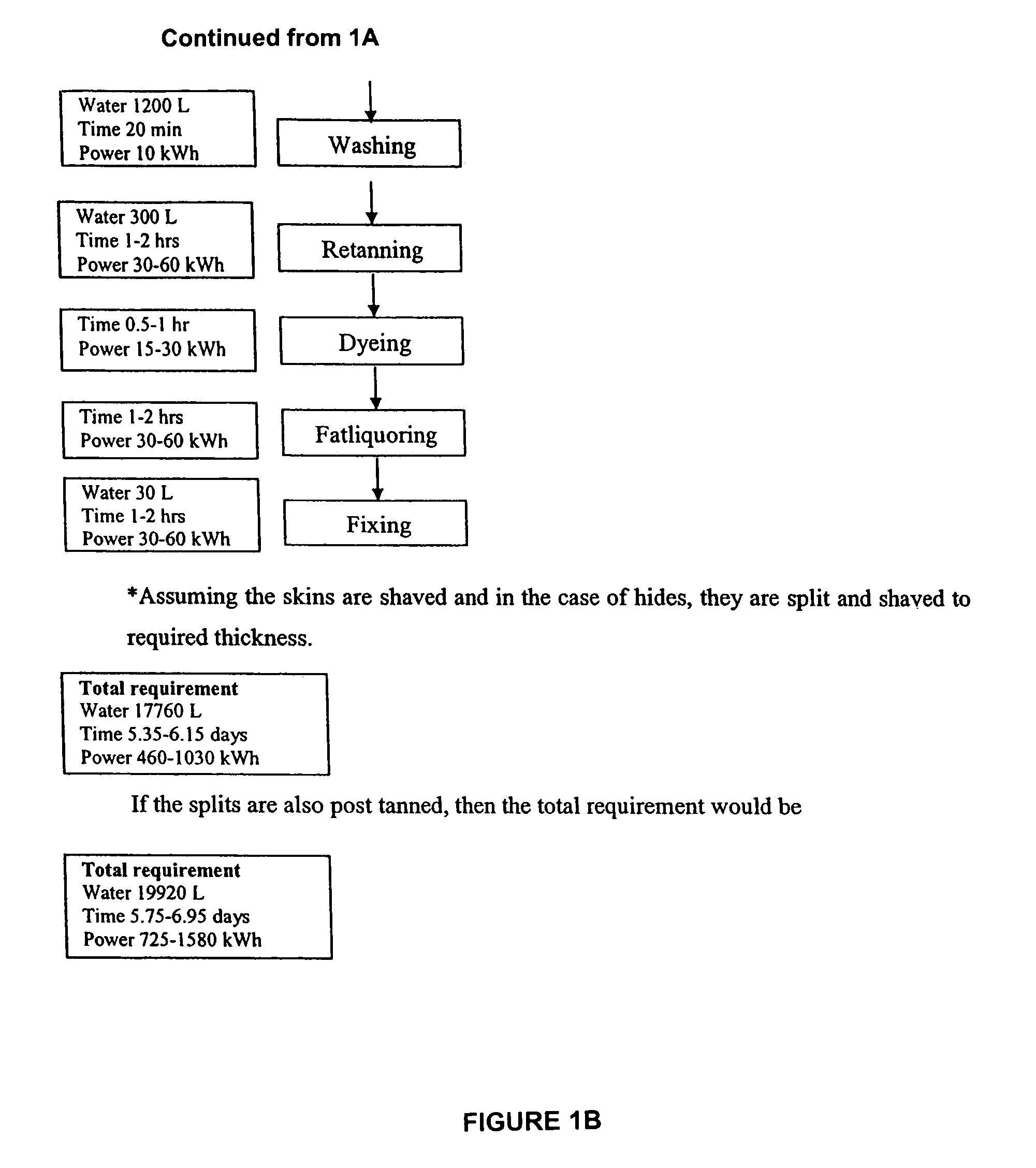Transposed process for making leather
a technology of transposing process and leather, which is applied in the direction of dyeing process, tanning treatment, leather surface finishing, etc., can solve the problems of no attempt to swap the leather processing steps, salt generation, etc., and achieve the reduction of steps, water consumption, power and time required, and pollutant generation.
- Summary
- Abstract
- Description
- Claims
- Application Information
AI Technical Summary
Benefits of technology
Problems solved by technology
Method used
Image
Examples
example 1
[0029]The present example was disclosed in U.S. patent application Ser. No. 10 / 618,997, filed Jul. 14, 2003, incorporated herein by reference.
[0030]534 gms of anthracene and 326 ml of concentrated sulfuric acid were added to a 2 liter round bottom flask fitted with a stirrer. The contents of the flask were heated to 140° C. for 90 minutes with continuous stirring. 1 ml of the mass was placed in a beaker and 3 ml water was added with shaking. It was observed to form a clear solution without a free naphthalene smell, confirming the completion of sulfonation. The sulfonated mass was transferred to a reactor fitted with a thermometer, stirrer and a dropping funnel. The mass was stirred continuously for a period of 10 min. while maintaining the temperature at 80° C. A mixture of 5.4 gms oxalic acid, 4.14 gms salicylic acid and 10 gms phthalic acid dissolved in 50 ml water was added to the above sulfonated mass and stirring was continued at 80° C. 1.5 gms of polymethacrylic acid was added...
example 2
[0031]Five bated goatskin pelts having fleshed pelt weight of 4.6 kgs were placed in a small experimental tanning drum. The cross section pH of the bated pelts was found to be 8.0.
[0032]The bated pelts were washed with 9.2 l water for 10 minutes and drained. A combination of syntans, 23 gms of Basyntan DI (phenolic condensed product from Badische Anilin-& Soda-Fabrik AG (BASF)), 23 gms of Vernatan OS (phenolic condensed product from Colour-Chem Limited, India), 46 gms of Basyntan FB6 (urea melamine based product from BASF) and 46 gms of Relugan RE (co-polymer based product from BASF) along with 6.9 l water was added simultaneously to the drum. The drum was run for 1 hr. 4.6 gms of Luganil FBO (acid dye from BASF) were added. The drum was run for 30 minutes. Then, an emulsion comprising a combination of the fat liquors, 46 gms of Vernol liquor PN (natural oil based product from Colour-Chem Ltd.), 46 gms of Vernol liquor ASN (synthetic fat liquor from Colour-Chem Ltd.) and 46 gms of B...
example 3
[0033]The present example was disclosed in Indian Patent Application No. Del / 770 / 2000, incorporated herein by reference.
[0034]105 gms of sodium meta silicate (Na2SiO3.5H2O) were stirred with 303 gms of sodium dichromate in a flask fitted with a stirrer. 550 ml of water were added to the above mass with continuous stirring. 188 ml of 98% sulphuric acid were added slowly to the above reaction mixture. 41 gms of molasses were added to 41 ml of water in a beaker and the resulting mixture was added drop by drop through a dropping funnel to the above mass over a period of 20 minutes with continuous stirring. The temperature of the resulting mixture was noted to be 95° C. A mixture of 40 gms of phthalic acid and 55 gms of sodium tartrate was added to this reaction mixture over a period of 10 minutes. 50 gms of molasses were added to 50 ml of water in a beaker and the resulting mixture was added to the above mass over a period of 30 minutes. A mixture of 43 gms of phthalic acid and 60 gms o...
PUM
| Property | Measurement | Unit |
|---|---|---|
| temperature | aaaaa | aaaaa |
| pH | aaaaa | aaaaa |
| temperature | aaaaa | aaaaa |
Abstract
Description
Claims
Application Information
 Login to View More
Login to View More - R&D
- Intellectual Property
- Life Sciences
- Materials
- Tech Scout
- Unparalleled Data Quality
- Higher Quality Content
- 60% Fewer Hallucinations
Browse by: Latest US Patents, China's latest patents, Technical Efficacy Thesaurus, Application Domain, Technology Topic, Popular Technical Reports.
© 2025 PatSnap. All rights reserved.Legal|Privacy policy|Modern Slavery Act Transparency Statement|Sitemap|About US| Contact US: help@patsnap.com


